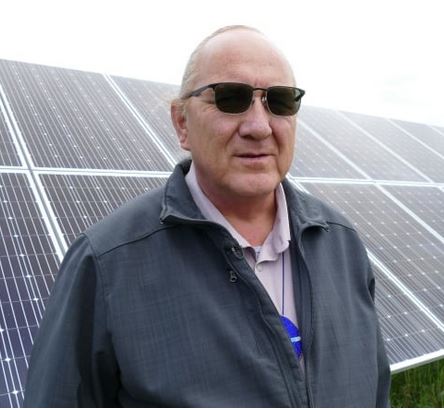Fisher River Cree Nation will soon be home to the biggest solar farm in Manitoba — a one megawatt facility that will be hooked up to the province's power grid — and its backers are hoping that the project will pique the interest of other First Nations.
"The focus of this particular project is revenue generation for the community," says David Crate, the chief of Fisher River.
The long-term planning is to … try and have as much of our community powered up on solar, and possibly other green energy initiatives.
Fisher River's solar farm, located about 200 kilometres north of Winnipeg, has almost 3,000 panels. It's what Manitoba Hydro calls "the first utility-scale solar project" in the province, and it spans seven acres and was built entirely by Indigenous employees.
The solar array is a partnership with W Dusk Energy Group Inc., an Indigenous-owned firm that specializes in solar, wind and renewable energy systems. The company helped design and manage the project.
According to Crate, the solar farm got the green light after an agreement was finalized a couple of years ago with Manitoba Hydro to have Fisher River sell the energy generated by the array to the Crown corporation's grid.
Renewable sources of energy are something that the owner of W Dusk Energy, David Isaac, believes more First Nations should be working toward.
The future is upon us," Isaac says. "I think we all have to collectively embrace it.
Isaac, who is Mi'kmaw, has been working in collaboration with First Nations for 20 years. His company helps First Nations with each project from start to finish, and he believes that developments like the solar farm align with First Nations values and philosophies.
"The community of the future is going to be like an Indigenous community, in the sense that hyper-localized power will be generated [by] decentralized utilities from a harmonic source of energy instead of extractive," Isaac says.
He added that Fisher River's solar farm could be used as a template for other First Nations that want to get involved in green energy.
For Crate, working with new renewable energy technology makes both economic and environmental sense for any First Nation.
"I'm hoping in the near future that we'll have across the country … a lot of green energy initiatives happening. It could be wind, solar, geothermal — technology is always changing," Crate says.
Employment and education
To fund the nearly $2.4 million project, the Fisher River community used its own money, along with a $1 million grant from Western Economic Diversification Canada and a $750,000 loan from RBC.
Crate says the project would not have been financially feasible 10 years ago, as the costs of a solar installation like this were more expensive back then.
The First Nation, which has 2,000 members living in the community and another 2,000 living off reserve, expects to pay off the loan in 10 years and to generate roughly $75,000 to $85,000 a year in profit after that.
Besides providing a source of revenue, the solar project has helped people in the community develop specialized skills.
Candice Sinclair has been working in Fisher River's construction industry for 10 years, and she's one of 11 people who went through a one-week training program to learn to install the panels on the solar farm. She then worked for six weeks on the installation project itself.
"It was the best paying job I've ever had," Sinclair says.
When fully operational, the farm won't require full-time employees, but it will need regular maintenance, and will have to be checked for dust and cleared of snow in the winter months.
And the training the team received sets them up for potential expansion work, as well as renewable energy projects in other communities. Future growth
The solar farm is not the first green energy project the community has undertaken, but it's the largest single installation. Over the years, Fisher River has also trained 15 certified local workers to install geothermal heating in more than 300 homes in the community to make them more energy efficient.
Lorne Cochrane, the chairperson of Fisher River's economic development team, said that since the homes installed geothermal heating, monthly hydro costs have gone from an average of $300 a month to $150.
Cochrane says one of the problems hampering Fisher River's economic development has been its location. A recent study showed that up to 70 per cent of the reserve's land is unusable due to high water tables and susceptibility to flooding.
Despite this limitation, he says with the work that has been done on energy, Fisher River has the opportunity to localize its own power and the potential to run its own utilities company some day, developing even greater expertise in renewable energy technology.
"That's our ultimate goal, to look at future expansion," says Cochrane.
Sinclair says she believes the solar array and the skills in renewable technology being developed in Fisher River will be beneficial for the First Nation in the long run.
She adds that her son and nephew asked her how it will benefit them and what it will do for the community's future. "And I said I have no idea right now … there's people [who] have different opinions on the solar farm, like some say we shouldn't have got it and others say it's going to benefit us, so it can work both ways. But I like it."
The solar farm in Fisher River is expected to be fully operational in early July.
Comment by D. Doodford: Generating 1 megawatt for a capital cost of $2.4 milllion with an operational cost of 6% pa and operating only 25% of the time, its energy will cost about 6.6 cents/kwh which is about half the cost of energy from Keeyask when it becomes operational.
